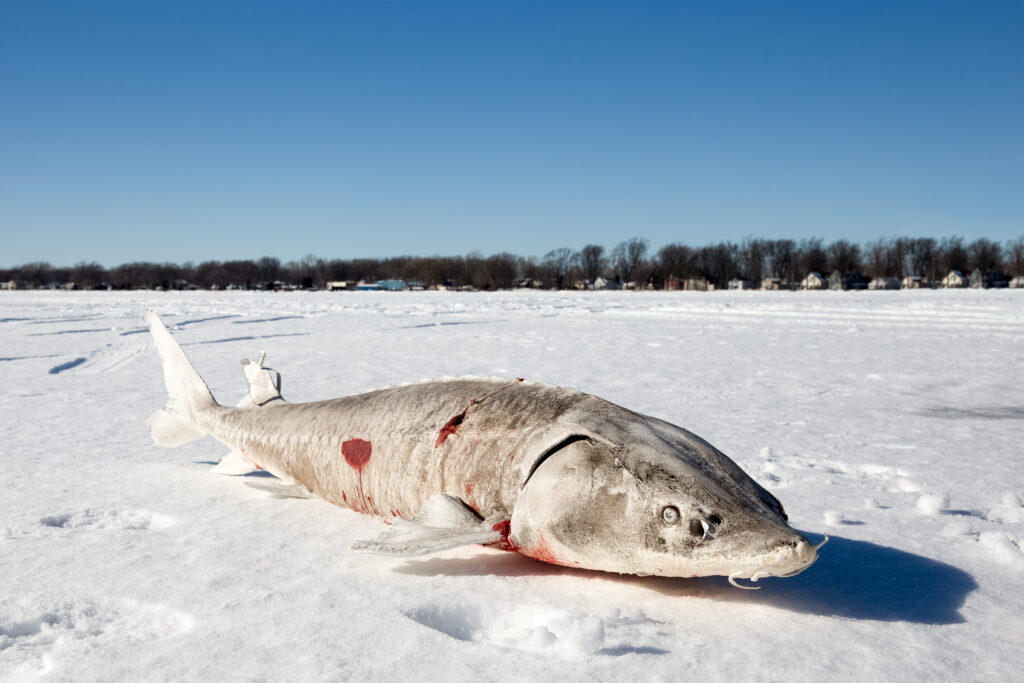Lake Winnebago sturgeon: One of the more popular migrating shacks payed off this…
Lake Winnebago, located in east-central Wisconsin, is renowned for its sturgeon spearing season, one of the most unique and culturally significant winter activities in the region. This tradition draws thousands of participants from across the state, as well as from outside Wisconsin, to harvest the prehistoric fish that inhabit its waters. With the ice-covered lake serving as both a winter wonderland and a prime location for sturgeon spearing, the “shacks” or ice houses, which are an essential part of the experience, play a central role in making the season successful.
One of the more popular migrating shacks on Lake Winnebago recently paid off in an unexpected way—highlighting both the importance of these portable homes and the community-driven nature of the sturgeon spearing culture.
The Role of Sturgeon Spearing Shacks
The concept of ice shacks—essentially small, portable shelters designed for sturgeon spearing—has been a staple of Lake Winnebago’s winter landscape for generations. These shacks are typically placed on the lake during the sturgeon season and allow spearfishers to stay warm while waiting for the prized fish to pass beneath the ice. Inside the shack, spearfishers use a hole drilled in the ice to peer into the dark waters below. The stakes are high, as catching a sturgeon requires both patience and skill. The fish can grow up to 7 feet long and weigh as much as 200 pounds, making them an impressive catch.
While some shacks remain stationary, others migrate throughout the lake to follow the sturgeon as they move between different feeding areas. These migrating shacks have become a part of the unique culture surrounding sturgeon spearing, adding an extra element of excitement and camaraderie to the season. For many spearfishers, the location of their shack is as much about tradition and community as it is about the pursuit of the sturgeon.
The Payoff
The migration of these shacks is not without its challenges, but recently, one of the more popular mobile shacks on Lake Winnebago experienced a payoff that is the stuff of legends. The shack, often moved to the hottest fishing spots during the season, had been strategically placed in a prime location this year, and after weeks of waiting and maintaining the shelter, it finally paid off with a successful catch.
As stories go, the owner of the shack—a seasoned spearfisher who had spent years perfecting his strategy—was determined to make this season count. The previous winters had been long, with little to show for his efforts, but this year, the migration of his shack took him to a place he had been eyeing for years. He moved his shack further out on the lake, near an area where the fish were known to be plentiful. After weeks of careful observation and intuition, he was finally rewarded with the catch of a lifetime: a massive sturgeon that measured 74 inches in length and weighed over 100 pounds.
For many in the sturgeon spearing community, this particular catch became a symbol of the patience, skill, and perseverance required to succeed. In a way, the shack’s migration represented the journey of the spearfishers themselves—constantly adapting, following the movements of the fish, and never giving up hope that the payoff would eventually come.
The Community Spirit
The success of the migrating shack wasn’t just a victory for the spearfisher himself—it was a victory for the entire community. Lake Winnebago’s sturgeon spearing season is as much about the tradition and camaraderie as it is about the actual hunt. Friends and families often gather in the shacks, share stories, and celebrate the history of the sport. It’s a time when people come together, whether they’re hoping for a catch or simply enjoying the peaceful solitude that the ice-covered lake provides.
The migrating shacks have also sparked a sense of community and connection that extends beyond the season itself. During the winter months, the people involved in sturgeon spearing are often seen helping each other out—whether by sharing tips, offering assistance with moving shacks, or providing food and drink during long days of waiting. There’s a shared understanding that success doesn’t come easily, and when someone finally hooks a sturgeon, it’s as if the entire community shares in the glory.
This sense of togetherness is what truly makes sturgeon spearing on Lake Winnebago special. It’s not just about the fish—it’s about the relationships built around the pursuit of the fish. Even those who don’t manage to catch anything still leave the season with memories of time spent with loved ones and the beauty of the lake.
The Economic Impact
Lake Winnebago’s sturgeon spearing season has also become an important economic driver for the region. The influx of spearfishers and spectators generates millions of dollars in revenue for local businesses. This includes sales of gear, equipment, food, and lodging, all of which benefit the surrounding towns and communities. The success stories of migrating shacks further fuel the enthusiasm of future participants, ensuring that the tradition will continue for years to come.
The community benefits are twofold: not only does the sturgeon spearing season provide an economic boost, but it also ensures that the traditions surrounding the fishery remain alive and well. The passion for sturgeon spearing is passed down through generations, creating a cycle of pride, knowledge, and tradition that extends beyond the immediate economic impact.
Conclusion
The tale of the popular migrating shack that paid off with the catch of a lifetime is more than just a success story for one individual. It’s a testament to the spirit of perseverance, the importance of community, and the deep-rooted traditions that make sturgeon spearing on Lake Winnebago such a beloved and enduring practice. For the spearfishers, the payoff isn’t just about the size of the sturgeon; it’s about the memories made, the friendships formed, and the celebration of a unique tradition that binds them to the lake and to each other. In the end, the migrating shacks aren’t just structures on the ice—they’re symbols of a culture that thrives on the patience and persistence of those who seek to catch the fish of a lifetime.



